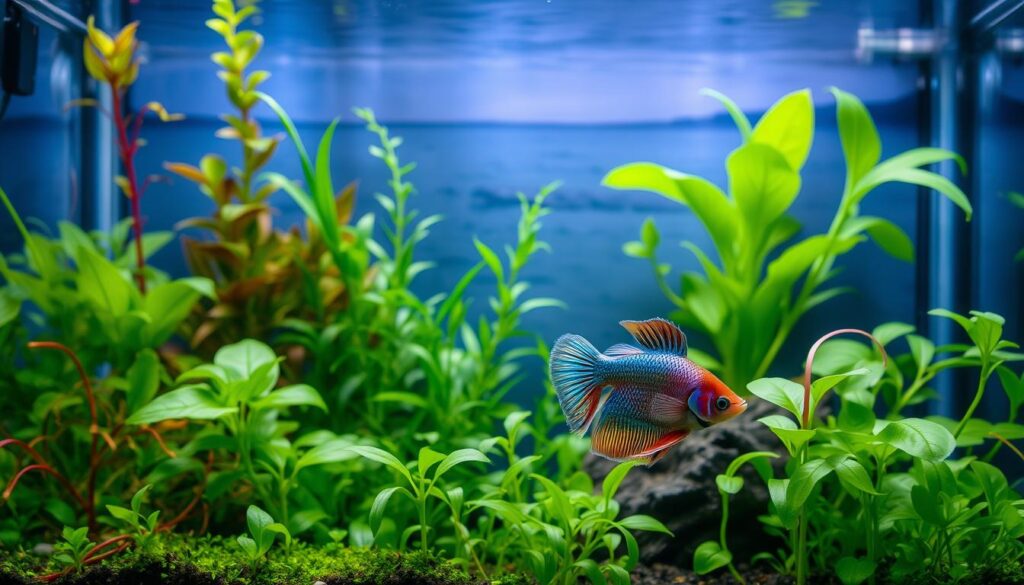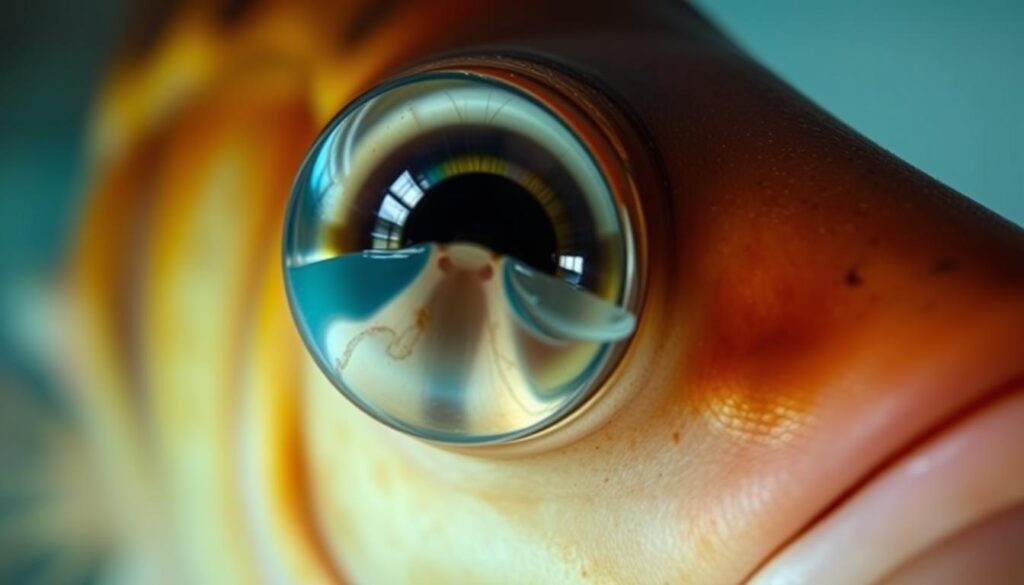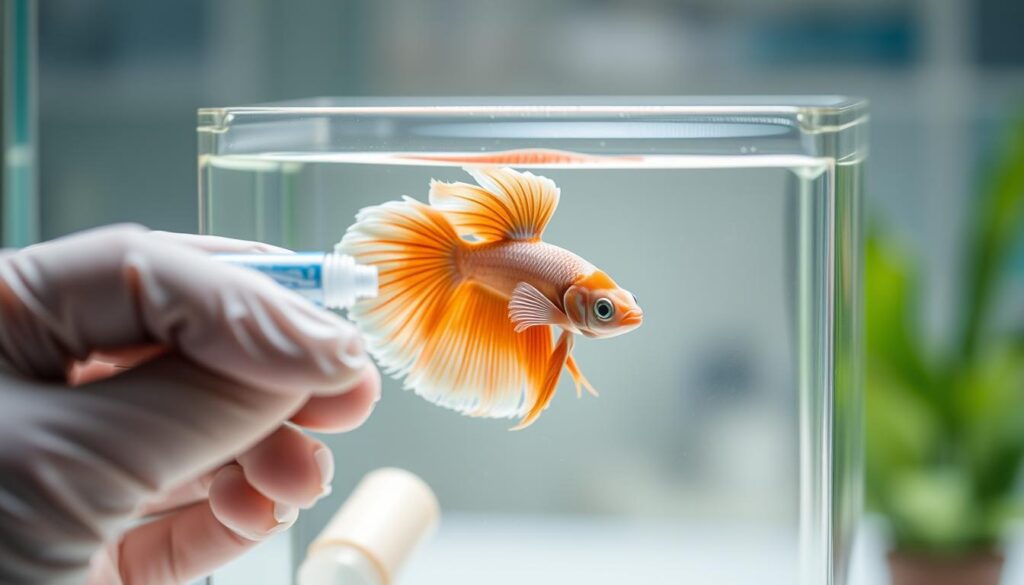Is your beloved betta looking a bit…bug-eyed? You’re not alone! Many pet owners have noticed this alarming condition, known as Popeye disease, in their aquatic friends.
Did you know that poor water conditions can lead to this unsettling issue? In fact, infection, injury, or inadequate aquarium maintenance can cause a betta’s eye to swell and bulge from its socket. Don’t worry, we’ve got you covered!
In this article, we’ll dive into the causes, symptoms, and treatment options for Betta Fish Eye Bulge. So, let’s get started and help your betta get back to its normal, stunning self!
Key Takeaways
- Poor water conditions can contribute to Popeye disease
- Infection and injury are common causes of Betta Fish Eye Bulge
- Proper aquarium maintenance is crucial for preventing this condition
- Recognizing symptoms early is key to effective treatment
- Treatment options are available to help your betta recover
What Causes Betta Fish Eye Bulge
If you’ve noticed your betta fish’s eye looking a bit bulgy, you’re not alone! Betta fish eye problems can be quite alarming, and it’s essential to understand what’s going on. So, what causes this eye-bulging condition? Let’s break it down!
Normal vs. Abnormal Eye Appearance
A healthy betta fish has symmetrical, proportionate eyes. If you notice any deviation from this, such as swelling or bulging, it could indicate an issue. Keep an eye out for any unusual appearance, as early detection is key!
Unilateral vs. Bilateral Bulging
Betta fish can experience eye bulge in one or both eyes. If it’s just one eye, it might be due to an injury. On the other hand, if both eyes are affected, it could be a sign of a more systemic issue, such as poor water quality or disease. The sources mention that Popeye disease can affect one or both eyes.
How to Recognize Early Signs
To catch eye problems early, observe your betta’s behavior and appearance closely. Look for signs like:
- Swelling or bulging around the eye
- Redness or inflammation
- Changes in behavior, such as rubbing against decorations
Early detection can make a significant difference in treatment and recovery!
Environmental Factors Contributing to Eye Problems
Your betta’s environment plays a crucial role in their eye health, and we’re here to explore the key factors. The tank conditions for your betta fish can significantly impact their overall well-being, including their eye health.

Poor Water Quality and Ammonia Buildup
One of the most significant environmental factors is poor water quality. Ammonia buildup can cause severe irritation and even lead to conditions like Popeye disease in betta fish. Regular water changes and proper tank maintenance are essential to prevent this issue. “Clean water is crucial for your betta’s health,” says a renowned aquarist. “Neglecting water quality can lead to a host of problems, including eye issues.”
To maintain good water quality, ensure you’re performing regular water changes (about 25% every week) and monitoring ammonia levels. Using a high-quality water conditioner can also help neutralize harmful chemicals.
Inadequate Tank Size and Conditions
The size of your betta’s tank and its conditions can also contribute to eye problems. A tank that’s too small can lead to stress, making your betta more susceptible to disease. Aim for a tank that’s at least 5 gallons, providing ample space for your betta to swim. Proper filtration is also crucial to maintain clean and healthy water.
Chemical Exposure from Cleaners and Medications
Chemical exposure is another environmental factor that can affect your betta’s eye health. Using harsh cleaners or medications improperly can lead to irritation and other issues. Always read the labels and follow instructions carefully when using any chemicals near your betta’s tank.
When it comes to betta fish care, being mindful of the products you use is vital. Opt for gentle, aquarium-safe cleaners and medications specifically designed for fish.
Temperature Fluctuations
Temperature fluctuations can stress your betta, potentially leading to eye problems. Betta fish prefer temperatures between 76°F and 82°F (24°C to 28°C). Avoid placing their tank near drafty areas, windows, or heating vents to maintain a stable temperature.
By controlling these environmental factors, you can significantly reduce the risk of eye problems in your betta fish. Proper betta fish tank setup and ongoing care are key to maintaining your betta’s health and happiness.
Disease-Related Causes of Eye Bulge
Disease-related causes of eye bulge in betta fish can range from bacterial infections to systemic diseases. When your betta’s eye starts to bulge, it’s a sign that something’s amiss, and it’s not just about the aesthetics – it’s about your fish’s health! Let’s dive into the different disease-related causes and what you can do to help your betta.
Bacterial Infections (Popeye)
Bacterial infections are a common cause of eye bulge in betta fish, often leading to a condition known as “Popeye.” This condition is characterized by a swollen or bulging eye, sometimes accompanied by redness or discharge.Prompt treatment is crucialto prevent further complications. According to experts, bacterial infections can be caused by poor water quality, stress, or injury.

Parasitic Infections
Parasites can also cause eye problems in betta fish. Parasitic infections can lead to irritation, swelling, and even bulging of the eye. Common parasites include protozoa and worms. Keeping your tank clean and well-maintained can help prevent parasitic infections.
Fungal Problems
Fungal infections can occur in betta fish, often as a result of poor water quality or stress. Fungal problems can cause a range of symptoms, including eye bulge, cotton-like growths, or discoloration.Maintaining good water qualityand providing a stress-free environment can help prevent fungal issues.
Systemic Diseases Affecting the Eyes
Systemic diseases, such as dropsy or tuberculosis, can also affect the eyes of betta fish. These diseases can cause a range of symptoms, including eye bulge, swelling, or discoloration. Systemic diseases often requireprompt and proper treatmentto manage.
| Disease | Symptoms | Treatment |
|---|---|---|
| Bacterial Infections (Popeye) | Swollen or bulging eye, redness, discharge | Antibiotics, improved water quality |
| Parasitic Infections | Irritation, swelling, bulging eye | Anti-parasitic medication, tank maintenance |
| Fungal Problems | Cotton-like growths, discoloration, eye bulge | Anti-fungal medication, improved water quality |
| Systemic Diseases | Eye bulge, swelling, discoloration, other systemic symptoms | Varies depending on the disease; consult a veterinarian |
By understanding the different disease-related causes of eye bulge in betta fish, you can take the necessary steps to provide your fish with the care they need to recover. Always monitor your betta’s health closely and seek professional advice if you’re unsure about the best course of treatment.
Physical Injuries and Trauma
Accidents can happen even in the most carefully maintained aquariums, and sometimes these accidents can lead to physical injuries for your betta fish. Whether it’s a scrap with a tank mate, a boo-boo from a sharp decoration, or a mishap during handling or tank maintenance, physical trauma can cause eye bulge.
Fighting and Aggression with Tank Mates
One common cause of physical injury is fighting between your betta and its tank mates. Betta fish are known for their territorial behavior, and when housed with other fish, conflicts can arise. Monitoring tank mate compatibility is crucial to prevent such incidents.
Injuries from Sharp Decorations
The decorations in your aquarium, while aesthetically pleasing, can sometimes pose a risk to your betta fish. Sharp edges or points can cause injuries, especially if your betta is actively swimming around decorations. Choosing decorations with smooth surfaces can help mitigate this risk.
Improper Handling Techniques
Handling your betta fish requires care and gentleness. Improper handling, such as netting your fish too aggressively or handling them too frequently, can lead to injuries. Learning proper handling techniques is essential for your betta’s well-being.
Accidental Trauma During Tank Maintenance
Tank maintenance is a necessary part of aquarium care, but it can sometimes result in accidental trauma to your betta fish. Being mindful of your fish’s presence during water changes or cleaning can help prevent such incidents.
By understanding the potential causes of physical injuries and taking steps to mitigate these risks, you can help ensure a safer environment for your betta fish and reduce the likelihood of eye bulge caused by trauma.
Diagnosing Betta Fish Eye Bulge
Diagnosing the cause of eye bulge in your betta fish requires a careful examination of visual symptoms and behavioral changes. To get to the bottom of the issue, you’ll need to be part detective, part scientist!
Visual Symptoms to Look For
When diagnosing betta fish eye problems, the first step is to look for visual symptoms. Check if the eye is bulging, red, or inflamed. You might also notice cloudy or discolored eyes. Take a closer look – is the bulge unilateral or bilateral? Are there any visible injuries or infections?

Behavioral Changes Indicating Discomfort
Betta fish with eye bulge often exhibit behavioral changes. They might become lethargic, hide more frequently, or show signs of discomfort when their tank is approached. Some bettas might even rub their eyes against decorations or the tank walls. Keep an eye out for these changes – they’re crucial clues to diagnosing the issue!
Using a Quarantine Tank for Observation
Setting up a quarantine tank can be a game-changer when diagnosing betta fish eye bulge. By isolating your betta, you can observe its behavior more closely and monitor the condition without the stress of tank mates or other environmental factors. “A quarantine tank is like a ‘fish hospital’ where you can closely monitor your betta’s condition and provide targeted care,” says a renowned aquarium expert.
Differentiating Between Various Causes
To effectively treat your betta’s eye bulge, you need to differentiate between various causes. Is it a bacterial infection like Popeye disease, or is it caused by physical trauma or poor water quality? By observing your betta’s symptoms and behavior, you can narrow down the possible causes and choose the best course of action.
As the saying goes, “The eyes are the windows to the soul” – and in this case, they can also be a window to your betta’s overall health! By carefully observing visual symptoms and behavioral changes, you’ll be well on your way to diagnosing and treating your betta fish’s eye bulge.
Treatment Options for Eye Conditions
Now that we’ve diagnosed the issue, it’s time to explore the treatment options for your betta fish’s eye condition! Treating your betta fish’s eye bulge effectively requires a comprehensive approach that addresses the root cause of the problem.
Immediate Water Quality Improvements
The first step in treating your betta fish’s eye condition is to ensure the water quality is optimal. This involves performing a partial water change to remove any toxins or waste products that could be exacerbating the issue. Regular water changes and maintaining proper water parameters are crucial for your betta’s recovery.
Medication Options and Proper Dosing
Depending on the cause of the eye bulge, various medications might be necessary. For bacterial infections, antibiotics like Kanamycin or Erythromycin are commonly used. It’s essential to follow the recommended dosage instructions carefully to avoid harming your betta fish.

Aquarium Salt Treatments
Aquarium salt can be an effective treatment for certain conditions, including some cases of eye bulge. It helps reduce swelling and promotes healing. However, it’s crucial to use the correct dosage, as excessive salt can be harmful.
Antibiotics: Types and Administration Methods
When it comes to antibiotics, there are several types and administration methods. For instance, Kanamycin is often used to treat bacterial infections and is typically administered directly into the tank water. Always follow the manufacturer’s instructions for the correct dosage.
Natural Remedies and Their Effectiveness
Some betta owners prefer to use natural remedies, such as tea tree oil or Indian almond leaves, to treat their fish. While these can be effective in certain cases, their efficacy can vary, and they should be used with caution. Always research thoroughly before introducing any new treatments to your betta’s environment.
In conclusion, treating your betta fish’s eye condition requires patience, the right treatment approach, and a commitment to maintaining optimal water quality. By exploring these treatment options, you can help your betta fish recover and thrive.
Proper Tank Setup to Prevent Eye Issues
Setting up your betta fish tank correctly is crucial for preventing eye issues. A well-designed tank not only keeps your betta healthy but also enhances its vibrant colors and active behavior. So, let’s explore the key elements of a proper tank setup that will keep your betta’s eyes shining bright!
Ideal Tank Size and Water Parameters
A minimum tank size of 5 gallons is recommended for betta fish. This size provides a stable environment and gives your betta ample space to swim. Water parameters are also critical: maintain a temperature between 76-82°F (24-28°C), pH between 6.5-8, and ensure water hardness is between 5-20 dGH.
Safe Decoration Choices
When it comes to decorations, avoid sharp or abrasive materials that can injure your betta. Opt for smooth rocks, plants, and gentle decorations that provide hiding places without risking your fish’s safety. Some great options include silk or live plants, driftwood, and rounded stones.
Effective Filtration Systems
A good filtration system is vital for maintaining clean and healthy water. Choose a filter that is gentle, as betta fish prefer calm waters. A sponge filter or a gentle hang-on-back filter is ideal. Regularly clean and maintain the filter to prevent it from becoming a breeding ground for bacteria.
Regular Maintenance Schedule
Regular tank maintenance is essential. Perform weekly water changes of 25-50% to keep the water fresh and clean. Regularly check water parameters and adjust as necessary. Cleaning the gravel and decorations during water changes will also help keep the tank environment healthy.
Compatible Tank Mates
While betta fish can thrive alone, some tank mates can be compatible if chosen carefully. Avoid aggressive or fin-nipping fish, and opt for peaceful, calm species that won’t harass your betta. Some compatible options include snails, shrimp, and certain species of tetras or corydoras.
By following these guidelines, you can create a thriving environment for your betta fish, significantly reducing the risk of eye issues and ensuring a happy, healthy pet.
Recovery and Prognosis
Let’s dive into the recovery process and prognosis for betta fish suffering from eye bulge. The journey to recovery can be quite a rollercoaster ride, but with the right care and attention, your betta fish can bounce back!
Typical Recovery Timeline
The recovery timeline varies significantly depending on the underlying cause of the eye bulge. For instance, if the issue is related to poor water quality, improvements can be seen within a week or two after addressing the water conditions. However, more severe cases involving bacterial or parasitic infections may take longer, sometimes several weeks, to fully recover.
Signs of Improvement
As your betta fish begins to recover, you’ll notice several signs of improvement. These can include a reduction in swelling, clearer eyes, and a return to their normal active behavior. It’s a relief to see your betta swimming around happily again!
Potential for Permanent Damage
Unfortunately, in some cases, the eye bulge can lead to permanent damage. This is more likely if the condition is severe or left untreated for too long. Regular monitoring and prompt treatment are crucial to prevent long-term effects.
Read Also Giant Betta Fish: Everything You Need to Know About This Majestic Beauty
Long-term Care for Affected Fish
Even after recovery, it’s essential to maintain optimal tank conditions to prevent a recurrence. Regular water changes, a balanced diet, and a stress-free environment are key to your betta’s long-term health. By taking good care, you can help your betta fish live a healthy, happy life.
Conclusion
We’ve explored the ins and outs of betta fish eye bulge, from causes to treatment and prevention. By understanding the environmental factors and disease-related issues that contribute to this condition, you can take proactive steps to ensure your betta lives a happy, healthy life.
Proper betta fish care involves maintaining a clean and stable environment, monitoring your fish’s health, and taking prompt action when issues arise. By following these guidelines, you can help prevent eye bulge and other common betta health issues.
As a betta owner, you’re not just caring for a pet – you’re creating a thriving community. By staying informed and engaged, you can provide the best possible life for your betta. So, keep exploring, learning, and sharing your experiences with fellow betta enthusiasts!

